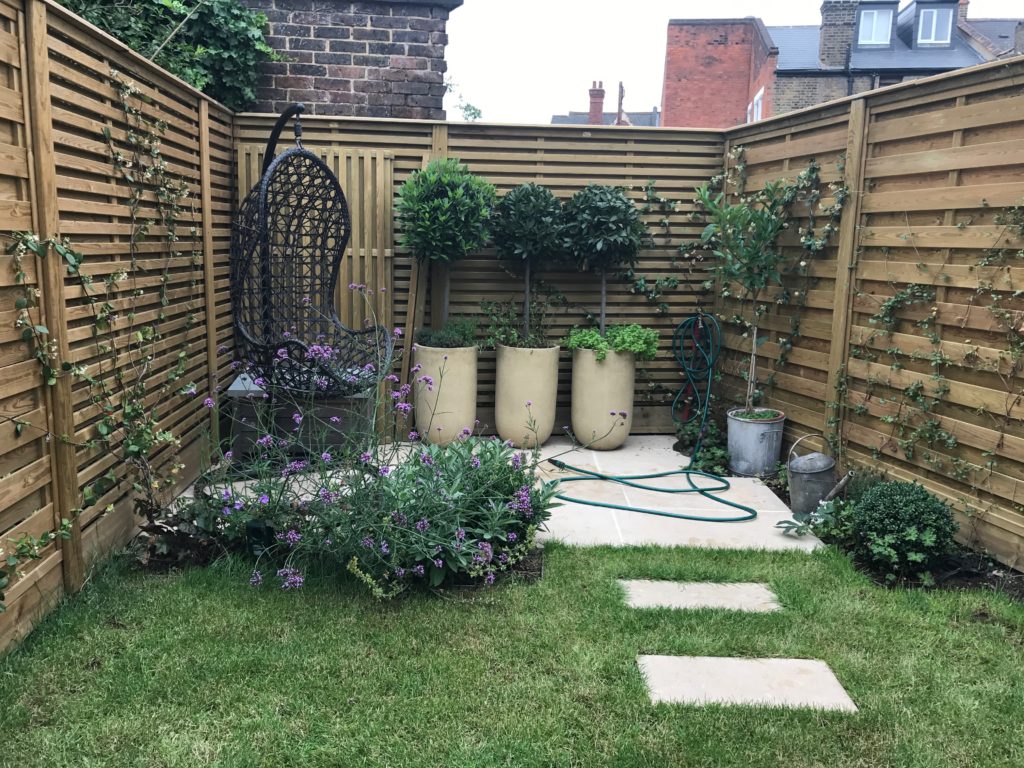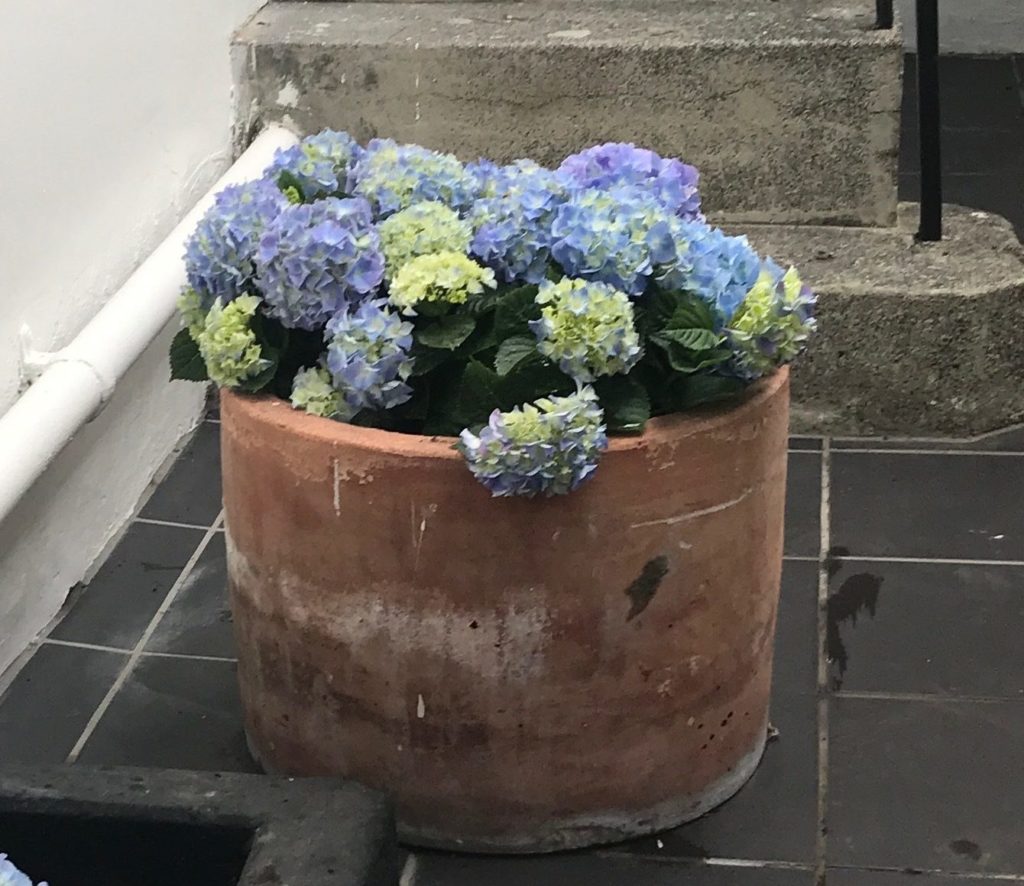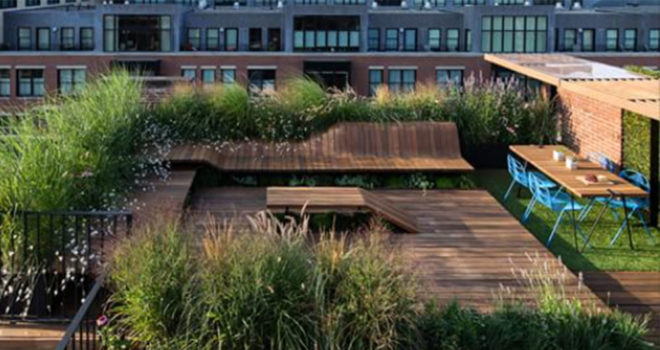For 2018, our trends emphasize the concept of providing pleasure to people in their gardens—whether it’s growing new foods, providing a refuge for wildlife, or creating a relaxing place to share a meal with loved ones. Enjoy!
1. EMBRACING THE SMALL GARDEN
These days, space is at a premium—but, designers are determined to make even the smallest of gardens useful and attractive. While small gardens are by no means new, we’ve noticed great progress in the way they are designed. In this case, less really can be more.
Here are two popular ways to make the most of a small garden:
Multipurpose Features: Everything in a small garden needs to have multiple uses. A concrete fire feature is a perfect example: It creates a bold element that runs through the space. It’s also a curb edge for the deck. It’s a planter. It collects water from downspouts on the house. It’s a seat wall. And, of course, at the end of the day it turns into a fire feature.

2. RETHINKING ALFRESCO DINING
For years, outdoor dining spaces have been conveniently located just off the house, near the kitchen. However, we’ve noticed dining spaces being pushed out into the garden. Yes, you’ll have to carry your plate a bit further, but it’s well worth it.
Many people automatically design outdoor dining spaces right off the back of the house. But making an all-inclusive destination within the landscape immerses people in the ambience. It makes for a more luxurious experience and guests get to see more of your garden.
Here are three tips for creating the ultimate outdoor dining destination:
-Surround the dining room with in-ground and container plants for a lush feeling
-Turn your dining area into a sanctuary with special flooring, lighting and furniture
-Include pre- and post-dinner entertainment spaces nearby, such as a fire pit or pool

3. MAKING CRAFTMANSHIP A PRIORITY
With so many mass-produced products around us, we often forget that people still make things by hand. The following examples prove that in the garden handcrafted is always best. We hope they encourage you to seek out an artisan next time you add a structure or other important element to your property.

4. RESTORING HABITAT AT HOME
Most gardeners are aware that bees and butterflies are in decline, but did you know that habitat loss is also impacting birds, frogs and even turtles?
Most of this dwindling habitat became our expanding cities and sprawling suburbs—spaces that have been designed for convenience and aesthetics, with little thought to the needs of local wildlife. Yet there is no reason we can’t create convenient, beautiful landscapes that also meet the needs of many, if not most, of our animal neighbours.
Many people are adjusting their plant selections and even redesigning their gardens to better support local wildlife. Here are some of our favorite takeaways for creating a habitat garden:
-Grow both seed-producing and berry-bearing plants
-Restrict or stop using insecticides
Consider replacing some or all of your lawn

5. EXPERIMENTING WITH WHAT YOU GROW
We love the willingness of gardeners to try new things. This year, we predict continued experimentation with new plants and how they are showcased. Following are three ways you can add some botanical variety to your garden or home.
Grow Unusual Edibles: There is a big, wide world of diversity available to gardeners through seed companies, seed swaps, and community gardens, so make your veggie garden reflect this trend and try a few new-to-you crops.
Food gardening continues to be incredibly popular with gardeners of all ages, a big part of the fun in food gardening is trying new edibles; from quirky cucamelons and burr gherkins to super-sweet ground cherries. From chickpeas and edamame to heat-tolerant, exotic greens like magenta spreen, sweet potato leaves, and amaranth.
And don’t forget the flowers! Include plenty of bee-friendly flowers into your garden to entice pollinators to food crops. Pollinators can increase your yield by ensuring your flowering crops like cucumbers, melons, and squash get pollinated. The best blooms for the veggie garden include sweet alyssum, zinnias, cosmos, nasturtiums, and calendula.
Get Creative with Houseplants: Don’t limit yourself to the typical pothos or ficus in a corner. Instead, think of houseplants as integral design elements in your private sanctuaries, fulfilling the same roles they do in the garden outside: leading the eye, creating focal points, providing repetition and contrast, framing views, and lending texture, color, and form.
Cultivate a Succulent Collection: Not too long ago the gardening public thought of succulents as cactus or jade and dismissed the entire category as too spiny or common. Today, it’s possible for anyone, anywhere to cultivate any kind of succulent. The plants like the same conditions you do: warmth, fresh air, sunlight, and dryness. What once was exotic is now available at your local nursery or via mail order. Even potentially immense succulents stay small and manageable in pots, which are portable and can be moved and sheltered where the weather turns too hot, too cold, or too wet for their liking.
